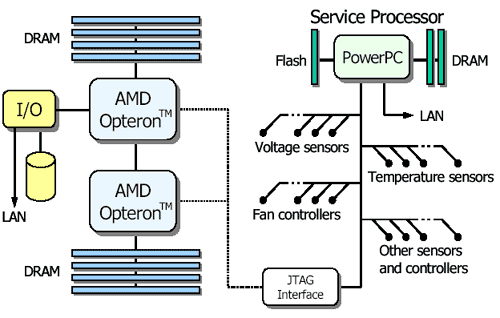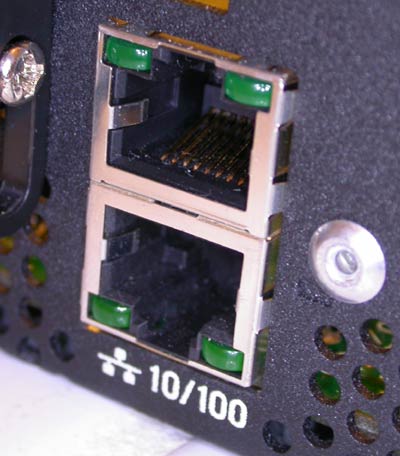AMD Opteron Coverage - Part 3: The First Servers Arrive
by Anand Lal Shimpi on April 23, 2003 9:41 PM EST- Posted in
- IT Computing
Newisys - Introducing the "Service Processor"
As we mentioned before, the key selling point of the Newisys design is its manageability features, it is also what Newisys specializes in. We introduced the Service Processor (SP) on the previous page, and now we'll explain exactly what the SP does:

As you can see from the above diagram, the SP is physically a PowerPC microprocessor - a Motorola MPC855T chip to be specific. The SP is always powered as long as the server has power; it runs off of a dedicated 3.3v voltage rail coming off of the Newisys power supply.

The Service Processor
The SP has its own memory controller, SDRAM as well as flash memory, so it is effectively an autonomous server within the Newisys 2100 design. Although it has no VGA output, the SP's output is redirected to a small display at the front of the server; not to mention that the SP is remotely configurable.
The benefit of giving the SP its independence is that regardless of the state of the rest of the machine, there is a part of the server that is fully accessible, just as long as it has power. You can even access the SP if you have no CPUs and no memory in the system; remember the SP has its own memory and BIOS.
The SP has a bus that interfaces with the Opteron allowing it to get state information from the CPU(s), which is useful in diagnosing what caused a particular failure. All of this data is recorded and stored by the SP so that regardless of what happens to the server, the data is still retained.

The SP's 10/100 Ethernet ports
Before we get to the real-world functionality of the SP there's one other note to make; the processor has its own 10/100 Ethernet controller. The benefit of this Ethernet controller is that the SP architecture is truly independent from the rest of the server as well as the rest of your network. You can connect the SP to a separate switch if you'd like to keep it separate and prevent it from cluttering up your otherwise neat IT structure. Newisys did mention that a number of customers could care less about this feature but they decided to include it regardless; the low cost of adding a 10/100 Ethernet controller was obviously not discouraging.
In the Target Market #2 section of this review we mentioned Intel's dynamically adjusting fans as one feature that was lacking with Athlon MP and Opteron servers; Newisys takes care of this by allowing the Service Processor (SP) to control the speed of all CPU/chassis cooling fans (basically, all fans but the power supply fans). The fan speed is adjusted based on the demands of the server; those demands are determined based on a number of probes setup in the system.
The basic features you would expect from a systems management engine are all here in the 2100:
- Remote administration of server (shutdown OS, reboot OS, etc…)
- Remote BIOS configuration and updates
- Desired Power Level Adjustment (through voltage/clock speed adjustments, you can set how much power your server draws, also done remotely)
- System Failure Notification
For details on everything supported by the Newisys System Management architecture be sure to read the whitepaper from Newisys.










0 Comments
View All Comments